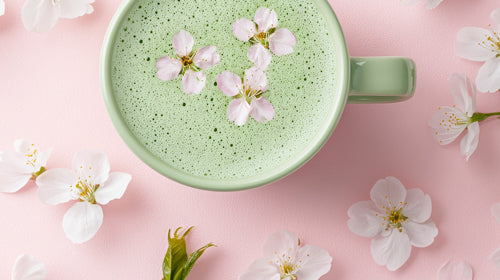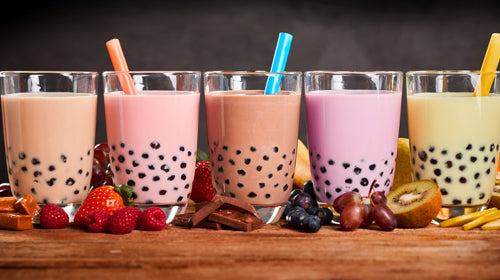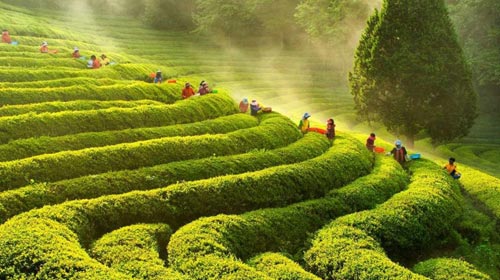Matcha latte is not only beautiful to look at, but also a real everyday booster. This creamy green drink combines high-quality matcha tea with milk to create a harmonious composition that energizes, calms, and inspires. In this article, you'll learn how to make your own matcha latte, the effects matcha has on body and mind, and why this green drink is a perfect coffee alternative.
How much caffeine is in a matcha latte?
Caffeine content in Matcha Latte: Gentle energy, long-lasting
A matcha latte provides a pleasant dose of caffeine—less than a strong espresso, but still more than classic green tea. One cup (about 1–2 teaspoons of matcha) contains around 60–80 mg of caffeine. By comparison, a cup of filter coffee contains around 90–120 mg, while green tea contains closer to 30 mg.
What makes the matcha latte kick so special? The caffeine in matcha takes effect much more gently thanks to its interaction with L-theanine. Your body absorbs it more slowly, ensuring sustained alertness without a sudden low – no nervous restlessness, no late crash. Instead of a quick coffee high, you get steady energy, coupled with pleasant calm and focused clarity. This keeps your energy level stable – ideal for those who want a fresh boost but want to avoid the ups and downs of coffee.
How can you reduce the calorie content of a matcha latte?
Cleverly reduce calories in your Matcha Latte
If you want a lighter version of the Matcha Latte, there are many ways to save calories – without sacrificing enjoyment or the creamy consistency.
How to make a low-calorie Matcha Latte:
Choose milk wisely: Plant-based alternatives such as unsweetened almond milk or oat milk from Oatly and Alpro are significantly lower in calories than traditional whole milk. Reduce sugar: Instead of honey or sugar, simply enjoy it without any sweetening, or use a few drops of stevia or erythritol. Keep an eye on portions: Even small adjustments such as less milk or just half a teaspoon of sweetener can affect the calorie count. Barista tip: Low-fat cow's milk (e.g. 1.5%) also produces a creamy foam – with fewer calories. This way you can customize your matcha latte and specifically reduce the calorie count – perfect if you want to combine enjoyment with lightness.
How many calories does a matcha latte have?
If you're watching your calorie intake, a matcha latte is a smart choice—especially compared to many classic coffeehouse drinks. The calorie content depends heavily on the milk and sweetener used.
Here is a rough guideline:
With 200 ml of whole milk and a teaspoon of honey, a matcha latte contains approximately 150–160 calories. If you substitute unsweetened almond or oat milk and forgo added sugar or syrup, the calorie content drops significantly. This makes the matcha latte with plant-based milk and little or no sweetener a light, delicious alternative to the classic latte.
What is Matcha Latte?
Matcha Latte is a hot drink made from powdered green tea and steamed milk. Finely ground matcha tea—a high-quality Japanese green tea—is mixed with water and then topped up with hot milk. This creates a smooth, slightly bitter flavor with a creamy texture and a characteristic green color.
Unlike classic green tea, matcha is not filtered but consumed as a whole powder – a crucial difference with many advantages.
Origin: Matcha from Japanese tea culture
Matcha originates from the traditional Japanese tea ceremony. The tea leaves come from the Camellia sinensis plant, are shaded before harvest, and processed with exceptional care. The resulting Matcha tea has been valued for centuries as a symbol of mindfulness, clarity, and inner balance.
In recent years, Matcha Latte has become a global trend – as a healthy lifestyle drink with depth, history and impact.
Matcha Latte Recipe – easy to make yourself
Ingredients for 1 cup of Matcha Latte:
-
1–2 tsp matcha powder (preferably organic)
-
60 ml hot water (approx. 80 °C, not boiling)
-
180–200 ml milk (cow's milk or plant-based alternatives)
-
Sweetener of your choice (e.g. maple syrup, honey, agave)
Preparation – this is how you make your Matcha Latte:
-
Sift matcha: Pass the powder through a sieve to avoid lumps.
-
Mix with water: Mix matcha with hot water – ideally with a chasen (bamboo whisk) or electric milk frother.
-
Heat and froth milk: Heat the milk of your choice and froth it until frothy.
-
Mix: Pour the milk into the mixed matcha. Sweeten if desired – your homemade matcha latte is ready.
Which milk goes best with Matcha Latte?
The choice of milk influences taste and consistency:
-
Oat milk: gently sweet, especially popular for matcha latte
-
Almond milk: light and nutty – ideal for a delicate aroma
-
Soy milk: rich in protein and neutral in taste
-
Cow's milk: classically creamy, full-bodied and filling
Tip: For the best taste experience, the milk should be unsweetened and barista-friendly.
Effects of Matcha Latte – healthy, focused and relaxed
Matcha contains caffeine, but it's combined with L-theanine, an amino acid with a calming effect. The result is long-lasting focus without jitters—ideal as a gentle alternative to coffee.
Other benefits of matcha:
-
High content of antioxidants (especially EGCG)
-
Anti-inflammatory effect
-
Supports metabolism and cell regeneration
-
Has an alkalizing effect and strengthens concentration
A regular matcha latte can give you energy without stressing your body – perfect for both body and mind.
Matcha Latte Variations: Creative Ideas for Your Green Drink
-
Iced Matcha Latte: with cold milk and ice cubes – ideal in summer
-
Vanilla Matcha Latte: with vanilla extract for a mild sweetness
-
Golden Matcha Latte: Matcha combined with turmeric and ginger
-
Protein Matcha Latte: with vegan protein powder as a pre- or post-workout drink
Tips for buying good matcha
When buying matcha, pay attention to the following quality features:
-
Color: bright emerald green
-
Origin: ideally from Growing Karma or from Japan (e.g. Uji or Nishio)
-
Organic quality: no pesticides or additives
-
Grinding: best stone-ground – for a fine, velvety texture
At Growing Karma, we will be using matcha from our permaculture, carefully ground, freshly bottled, and rich in chlorophyll – a truly natural product with depth.
Conclusion: Matcha Latte is more than a trend
Making your own matcha latte not only brings you a delicious hot beverage, but also a taste of Japanese tea culture, mindfulness, and health. The green powder from the Camellia sinensis plant has an invigorating, antioxidant-rich effect and improves your concentration – all without the caffeine crash.
Try it out and find your personal favorite. A matcha latte in the morning or afternoon can become your new ritual for focus, enjoyment, and balance.




Leave a comment
This site is protected by hCaptcha and the hCaptcha Privacy Policy and Terms of Service apply.